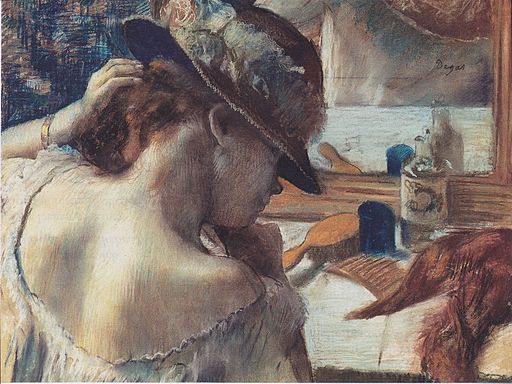
Ballet Rehearsal,1873
Master of pastel, and an artist that really needs no introduction, Edgar Degas was born July 19 (day before my birthday!!) 1834 in Paris. Degas is interesting in that he started as a very Classical artist that changed direction towards a realist study of modern society with keen powers of observation and attention to color. Technically, Degas deserves particular merit for his experimentation with materials, especially in the way he would prepare his pastels such as combining them with water and steam into a thick paste, and even mixing them with oil paint sometimes. Gracefulness (as well as awkwardness) is a common theme in his work, especially in the numerous works of ballet dancers and women bathers, yet he also depicted people with casual realism, neither enobling them nor making them ugly. He was also a pioneer in making use of the camera as a reference tool for his art.
Above we see ballet dancers in an airy room with light spilling onto the subjects from large windows. Degas makes good use of two-point perspective here. On the far left we see a violinist playing for the students as they warm up. One can almost hear the strings pierce the echoey room. There is no specific subject here, which makes this piece incredibly modern...the dancers getting ready for a vigorous class is all that this work is about, and yet it is so peaceful. Note the subtle purples and greys Degas uses to describe the floor, while the walls range from greens to purplish greys, while our eyes leap to the green foliage outside the far right window. Degas recognized that everyday life can be just as interesting as the noble and Classical.

In Front of the Mirror,ca.1899
Degas' incredible hatching and cool skin tones are what make this study captivating. The facial expression seems to be irrelevant, and from looking at much of Degas's work I think that he admired anatomy and not so much people. The female form in his eyes always appears nonchalant and devoid of character, yet still intriguing. According to many of his biographers he wasn't the cheeriest person to hang out with either, and ultimately ended up a blind loner in his last years. But he was an astute observer of people and their surroundings, and the daily activities he captured them in were more interesting to him than who they were.

A Cotton Office in New Orleans,1873
This is a wonderful piece. Once again Degas uses two-point perspective from what appears to be a photograph. Degas heightens the color contrast with warm green walls and a vivid orange floor that is balanced by the blacks of the men's suits and the sparing but effective use of white. Degas takes something so ordinary and compels us to watch. It is the complex arrangement of the figures in this space that makes the painting effective: a strong horizontal of figures that are all focused on the cotton on the table, while curiously the foreground figures look away from this, caught up in their individual activities. Again, this idea of making an activity or profession the subject itself, with the people as objects within the painting is so simple yet so effective. People are most natural when they are doing something, not just "posing".

Ballet Exam, ca. 1850
Another variation of the ballet class using more dramatic color and perspective, giving a sense of presence and space that makes us feel like we are in the room with them. Texture plays a large part in this work...smooth wooden boards of the floor, wispy fabric of the dresses, the music sheet stand with a glint of highlight on the paper,and the mirror reflecting the dancers and the bright afternoon sky outdoors. Had Degas lived another hundred years to make films he would have changed cinema forever, and in some ways his influence was felt anyway. Without drama, his sense of quiet participation in the everyday opens our eyes to the world.

Ballet School, ca. 1850's
An uncharacteristic warm palette dominates this room, and even still Degas manages to sneak in bits of green wherever he can. This time a single girl performs while the other students watch, and violinist plays...note again two-point perspective that is much more subtle, and with deeper tones of value. Strong horizontals again dominate this work, and strict attention to individual expression breathes life into the room. This is pure poetry. This is Degas.
Comments
Post a Comment